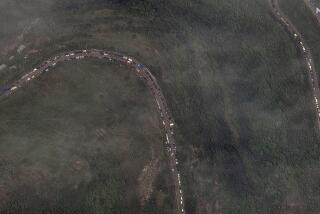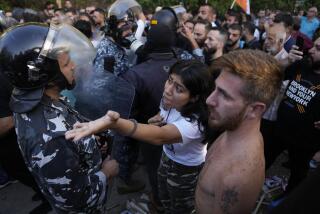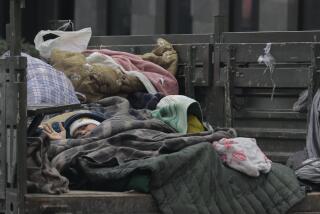Changing Lifestyles : Turkey: Role Model for Soviet Asia? : Seeking economic direction, leaders of the new republics are heading for Istanbul.
- Share via
ISTANBUL, Turkey — Amid the bloodstained shirts of Turkish heroes and the gorgeous campaign tents of the Ottoman Empire, a dusty board in Istanbul’s military museum lists what Turks learn are the 16 independent Turkish states of history.
For 70 years, that list has stayed nearly static, with the Turkish Republic standing alone as the last proud successor to a Turkic-Mongol line that includes the Huns, Genghis Khan and the Golden Horde.
Now states and loyalties are changing fast, especially in the Central Asian plateau from which the Turks swept West nearly a millennium ago and where they still dominate five of the six mainly Muslim republics in the disintegrating Soviet Union.
This emerging group of states and their 50 million inhabitants are among the 180 million people around the world who speak some form of Turkish.
A joint secretariat and consultations are helping these Central Asian republics overcome a recent history of mutual hostility and plot their future course. To the north there are the Slavs, who have colonized them for the last two centuries. To the south is the Islam they acquired in medieval times. And to the west are their kinsmen in westernizing Turkey.
By the end of last week, all five of those Turkic republics, as well as Tadzhikistan (whose people are related to the Iranians), had agreed to join the commonwealth proclaimed by Russia, Belarus and Ukraine.
With their economies inextricably bound up with Russia and most of their politicians of firmly ex-Communist stock, the choice is not all that surprising. But the Central Asians have also made it plain they resent having been presented with a virtual fait accompli.
And as they have scouted future alternatives, their first foreign port of call has often been Turkey, a country whose transformation over the last decade from a command economy toward a market economy makes it an attractive model.
The leaders of Kazakhstan, Turkmenistan and Azerbaijan were first to knock at Turkey’s door over the last months. The president of Uzbekistan arrived Monday, and his counterpart from Kyrgyzstan is due within a few weeks.
Turkey became the first and only country to recognize Azerbaijan’s independence from Moscow last month, and on Monday the Turkish Cabinet voted to recognize all the former republics--including those in Central Asia--that have declared their independence.
“We have some sympathy with them, but sympathy is not enough. We should recognize them prior to anyone. But we must be sure that our recognizing them will not create any problem for them,” Prime Minister Suleyman Demirel had said earlier.
Turkey finds the Central Asian interest gratifying. A few Turks even say that a whole foreign policy should be built around the newly autonomous Turkic republics.
The Turkish Foreign Ministry is already forming a new “Eastern Department” to deal with the former Soviet republics. Also, a joint bank will be set up under Turkey’s Eximbank, and the satellite Turksat will be ready by 1993 to relay national television to fellow Turks from Berlin to Alma Ata in Kazakhstan.
“We did not want to call it the ‘Turkish Department’ for fear everybody would start accusing us of pan-Turkism,” said Bilal Simsir, who led a Turkish Foreign Ministry delegation to Soviet Central Asia in September. “Why is it that for us to know a Western composer is considered civilized but that it is backward to know the work of a Turkmen poet?”
The ideology of a pan-Turkic union was virtually extinguished in Turkey when winter snows wiped out the armies of the World War I Ottoman leader Enver Pasha as he marched east to unite the Turks.
Despite goodwill and much-trumpeted joint projects, especially in Azerbaijan, real progress has often been slow.
Direct Turkish Airlines flights to the Azerbaijani capital of Baku have been irregular, and only top Azerbaijani officials benefit from Turkish television broadcast feeds and new telecommunications links on the Turkish domestic telephone network.
Few Turks suggest that a Turkic-Muslim Central Asian bloc, however rich in natural resources, can ever substitute for Turkey’s ever-stronger economic links with Europe, with which it does more than half its trade, or even with Slavic states such as Ukraine and Russia.
Turkish officials mainly hope that the West will help the secular, democratic Turkish model to counter competition from Muslim fundamentalist Iran or lavishly funded Saudi Arabian projects.
A major first test is the question of which alphabet the Turkic lands will choose--the Cyrillic promoted by Russia, the Arabic script of their ancestors promoted by Saudi Arabia and Iran or the Latin script adopted by Turkey in the 1920s.
Already, scholars have met in Istanbul to try to work out a new shared Turkic script, based on Latin. Azerbaijan has, in theory, already opted for Latin, but no irreversible decisions have been made. The change will involve major spending on retraining, new printing presses and computers.
“Turkey cannot afford this. The West should help,” said one senior Turkish official. “To be so cautious is unrealistic. The Russian Empire is finished in their Central Asian colonies. I wish the United States had a more active policy.”
Washington even gently rebuked Turkey for its hurried recognition of Azerbaijan’s independence, a decision taken partly due to a belief that Ankara might otherwise be beaten to the post by Iran, which is home to more than 10 million ethnic Azerbaijanis.
Iran later declared that it would not recognize Azerbaijan’s independence, which earned Iranian Foreign Minister Ali Akbar Velayati heckling and abuse during an official visit to Baku this month.
Western diplomats see that it would be in the West’s best interest for the Turkic states of the disintegrating Soviet Union to adopt Turkey’s pro-Western model, especially after seeing Turkey’s attempts to be even-handed in disputes between the Soviet republics of Armenia and Azerbaijan.
“Turkey can make the situation a great deal better or a great deal worse. . . . Potentially, it is a very calming influence,” said one European ambassador.
But while the ex-Communist leadership and elites might like the Turkish model, it is not yet proven that the rural masses feel closer to a Turkish identity than to Islam.
Turkey, Iran and the Soviet Muslim Republics: A Primer
* TURKEY
Capital: Ankara
Population: 58.6 million
Ethnic Breakdown: 80% Turkish, 17% Kurdish
Religious Breakdown: 99.8% Muslim (mostly Sunni)
Land Area: 301,382 sq. mi.
Per Capita GNP (1990): $3,100
* IRAN
Capital: Tehran
Population: 59.1 million
Ethnic Breakdown: 51% Persian, 21% Azerbaijani, 9% Kurd
Religious Breakdown: Predominantly Muslim
Land Area: 637,065 sq. mi.
Per Capita GNP (1990): $1,400
* AZERBAIJAN
Capital: Baku
Population: 7.1 million
Ethnic Breakdown: 78% Azeri, 8% Russian, 8% Armenian
Religion: Predominantly Muslim
Land Area: 33,400 sq. mi.
Per Capita GNP(1989): $3,750
* TURKMENIA
Capital: Ashkhabad
Population: 3.6 million
Ethnic Breakdown: 68% Turkmens, 13% Russian, 9% Uzbek, 3% Kazakhs.
Religion: Predominantly Muslim
Land Area: 188,455 sq. mi.
Per Capita GNP(1989): $3,370
* UZBEKISTAN
Capital: Tashkent
Population: 20.3 million
Ethnic Breakdown: 69% Uzbek, 11% Russian, 4.5% Tadzhik
Religion: Predominantly Muslim
Land Area: 172,740 sq. mi.
Per Capita GNP(1989): $2,750
* TADZHIKISTAN
Capital: Dushanbe
Population: 5.1 million
Ethnic Breakdown: 59% Tadzhik, 23% Uzbek, 10% Russian, 2% Tatar
Religion: Predominantly Muslim
Land Area: 55,250 sq. mi.
Per Capita GNP(1989): $2,340
* KYRGHYZSTAN
Capital: Frunze
Population: 4.4 million
Ethnic Breakdown: 52% Kirghiz, 22% Russian, 13% Uzbek, 3% Ukrainian, 2% Tatar
Religion: Predominantly Muslim
Land Area: 76,640 sq. mi.
Per Capita GNP(1989): $3,030
* KAZAKHSTAN
Capital: Alma-Ata
Population: 16.7 million
Ethnic Breakdown: 40% Russian, 36% Kazakh, 5% Ukrainian, 2% Tatar
Religion: Predominantly Muslim
Land Area: 1.05 million sq. mi.
Per Capita GNP(1989): $3,720
Sources: The World Fact Book 1991; Facts on File, August 29, 1991; PlanEcon.
More to Read
Sign up for Essential California
The most important California stories and recommendations in your inbox every morning.
You may occasionally receive promotional content from the Los Angeles Times.













